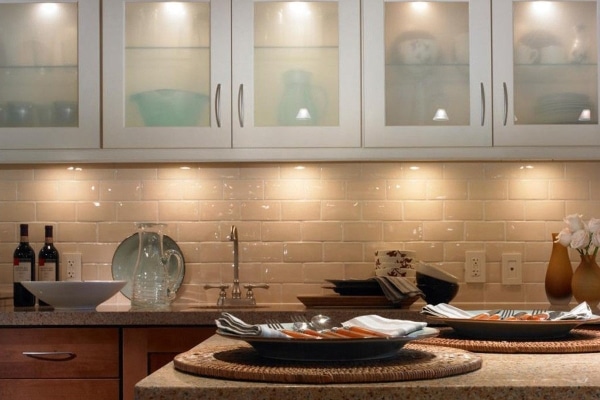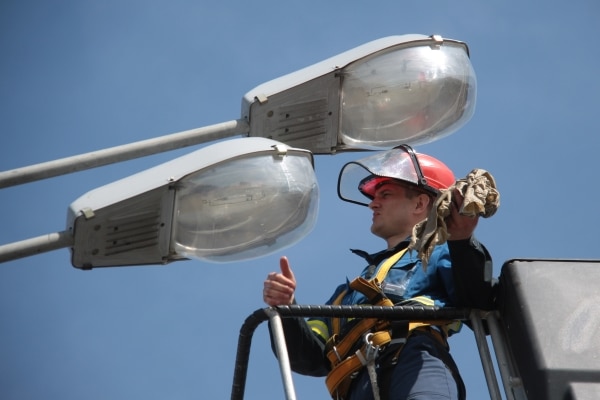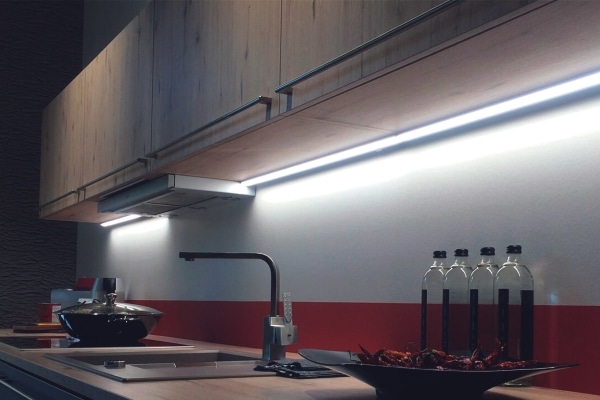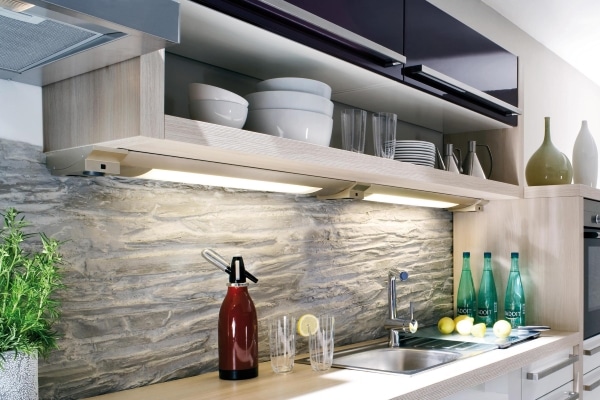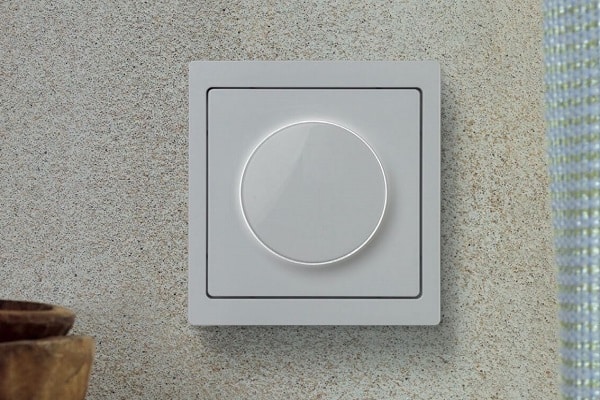Proper lighting affects not only the aesthetics and beauty of the interior, it also affects the state of the microclimate in the room. The best lighting option for stretch ceilings in any room will be linear lights.
- Design features and elements
- Main characteristics
- Power
- Glow color
- Light flow
- Dimensions
- Case color
- Installation method
- Manufacturer
- Price
- Advantages and disadvantages of using
- When is it advisable to install linear fixtures?
- Types of linear fixtures
- LED
- Fluorescent
- How to install linear fixtures on a stretch ceiling?
- Popular manufacturers
- Lightstar
- Exmork
- Lucide
- Globo
- EKF
Design features and elements
The body of a typical linear luminaire looks like the body of a fluorescent lamp. At the same time, the linear luminaire has a clearer and more powerful luminous flux.
Among the advantages of linear LED luminaires are durability, better perception of shades, stable and high-quality lighting. Because of this, they are widely used in the following areas:
- offices;
- offices of medical institutions;
- laboratories;
- banking institutions;
- kindergartens, schools, colleges and universities;
- retail space;
- cafes and other catering establishments.
The design of a typical linear luminaire consists of the following elements:
- profile;
- pipe fastening bolts;
- optical polycarbonate;
- LEDs;
- printed circuit board made of aluminum;
- plugs;
- LED power drivers;
- network wire;
- pressure seal;
- cover, its gasket and screws for fastening.
Main characteristics
There are many models of linear luminaires, each of which differs in power, body and glow colors, luminous flux, dimensions and other characteristics. Consider the main parameters by which such lighting devices are selected.
Power
The power of LED-lamps, including linear ones, is lower than that of other types of lamps. The average power of LEDs can vary from 12 to 24 watts.
Glow color
The indicator determines the shade of the backlight. The color of the glow depends on the color of the steel present in the composition of the lamp lamp. It is also affected by color temperature, measured in degrees Kelvin.
For residential premises, a color temperature of 3600 ° K is sufficient, respectively, the tint of the glow will be yellow. For public places, including offices, luminaires with increased performance – 4500°K and more are required (for better concentration of employees at work).
Light flow
The recommended luminous flux is important. It varies, depending on the room in which LED-lamps are installed:
- for a hallway or living room – from 22 to 24 W / sq. m;
- for a playroom or children’s room – 60 W / sq. m;
- for a utility room or bedroom – 15-16 W / sq. m;
- for a shower room, a bathroom, a bathroom – from 18 to 20 W / sq. m.
Dimensions
To date, there are no specific standards regarding the dimensions of linear luminaires. Their width and length vary. Usually the width does not exceed 36 mm, the length reaches from 30 to 284 cm.
Long lamps are optimal for large halls or corridors with high ceilings. They are also useful for hanging kitchen cabinets located on one wall. And for small cabinets and small rooms, it is advisable to choose shorter fixtures.
Case color
Most linear luminaires have housings in white. Models with silver and black cases are also common. There are also made in other colors.
Installation method
According to the design and installation method, linear LED luminaires are divided into 4 types:
- Suspended. Mounted on hangers of various lengths. The latter can become interesting decorative elements of the interior.
- Corner. Placed under shelves, cabinets or in niches. They are used not only for lighting, but also as decoration.
- Overhead. They, unlike built-in ones, have a visible case. They are easier to mount, which is a definite advantage. Such lamps are easy to attach to the ceiling or walls.
- Embedded. Especially widely used in the installation of stretch ceilings. In this case, the light-emitting glass remains on the surface. It is more difficult to integrate such lamps into concrete floors.
Manufacturer
When it comes to choosing linear luminaires , the manufacturer matters. Among the best brands producing such products are IEK, EKF and Lighting Technologies, for which the quality of products comes first.
Price
When choosing LED luminaires, most consumers are looking for the best value for money. The following factors affect the cost of lighting fixtures:
- Lamp format. If 1 office or household lamp costs from 200 to 300 rubles, then outdoor counterparts can be purchased at prices from 1100 to 1800 rubles. a piece.
- Brand (manufacturer). Products from Western manufacturers are more expensive than lamps from domestic or Chinese companies, but the level of quality is usually higher.
- Number of diodes. The density of the light flux and the brightness of the glow of the tape depend on them.
- power and other factors. The indicator also affects the brightness of the glow of the tape and the degree of its heating. It is recommended to use an aluminum profile for heat dissipation purposes.
Advantages and disadvantages of using
Although linear fixtures are widely used, many users are not well aware of their features. The advantages of such lamps:
- The absence of a shadow. Linear models do not create shadows due to the uniform illumination of the premises, unlike other lighting fixtures.
- Versatility. Lamps can be used for any purpose.
- Environmentally friendly (LED lamps do not contain mercury).
- Modularity. To obtain the required light accents, the luminaires can be designed in different ways.
- The most even and high-quality lighting, comfortable for the nervous system and human vision.
- Reliability and resistance to vibrations.
- Instant on.
- Long service life. On average, it is 12 years. Depending on the model, the period varies from 50 to 100 thousand hours, which is an order of magnitude longer than that of incandescent lamps.
- Low electricity consumption, which allows you to save on its payment.
- Color rendition at the highest level, which ensures the correct visualization of objects.
- Possibility to select the lighting temperature (from warm to cold light).
- Low heating, making linear LED luminaires the best option for stretch ceilings.
- Resistance to temperature changes and mechanical influences.

However, linear LED lamps also have disadvantages:
- Voltage fluctuations may cause damage. If the drops are significant, one built-in power supply is not enough – additional protective blocks are required.
- The device needs to be replaced if the power supply fails.
- The need for a heat sink. Especially for this, a substrate is attached to the LEDs. When it is detached, the heat sink is disturbed, which leads to the failure of the lamps.
When is it advisable to install linear fixtures?
The use of linear LED lamps is relevant in the following cases:
- With severe wear and tear of electrical networks. Almost all sockets indicate a voltage of 220 V, but in fact it reaches a maximum of 160 V. LED lamps guarantee the most reliable start.
- With limits on electricity consumption. In many areas, including industrial ones, there is a shortage of electrical capacities, which forces the establishment of limits on electricity consumption. LED lamps consume up to 15% of energy, which makes their use optimal.
- When building new facilities. In this case, the use of LED luminaires makes it possible to reduce the cost of installing transformers and allocating power by a factor of four.
- Under adverse operating conditions. Vibrations are typical for cranes, drilling rigs, compressor stations and other equipment.
This negatively affects the functioning of incandescent lamps, leads to their failure. LED luminaires are characterized by resistance to vibrations. - In rooms requiring constant lighting. In many of them, the height of the suspension of fixtures often exceeds 3.5 m, and incandescent lamps need to be constantly replaced. With LED lamps, this problem disappears, because they provide uninterrupted lighting for a long time.
Types of linear fixtures
Linear luminaires are classified not only by design and installation method, but also by composition. There are LED and fluorescent linear lamps.
LED
A linear LED-lamp is a lamp, inside which diodes are responsible for the light. They provide the most comfortable light for the eyes, are durable, inexpensive and do not flicker like fluorescent lamps.
Fluorescent
Fluorescent fixtures contain mercury in the light tube. The substance increases light output by increasing the number of free electrons. The latter are created as a result of ionization of mercury atoms.
The current in the light tubes flows through a mixture of mercury vapor and argon. The current channel is formed by a gas cloud with a voltage of 1 kW. The electrical discharge creates UV radiation, which the phosphor layer converts into a light flux.
Fluorescent lamps are divided according to many criteria: the shape of the bulb, size, power, light output, etc. For example, T8 lamps are straight tubes with a diameter of 2.54 cm.
How to install linear fixtures on a stretch ceiling?
Regardless of the type of lamp, the installation technology for all lamps is the same. The installation process consists of several steps:
- Design a lighting scheme, determine the number of fixtures and their required power. Draw the project, taking into account all the proportions and sizes, features of the ceiling. Determine the location of each lamp.
- Select the desired lighting option (for example, central or side lighting). Using a tape measure, a marker and a square, make markings on the ceiling.
- Solve the issue with the functioning of additional lighting. It is possible to install a separate or general switch for the chandelier and additional lamps. Determine the future location of the switch, mark it with a marker.
- Use straight lines to connect all the dots on the wall and ceiling. Focus on them to install the electrical cable.
- Next comes the actual wiring. Measure the distance from the ceiling to the lower level of the profile where the fixtures are to be placed.
- Attach metal or plastic clamps to the ceiling at the marking points. They will be needed in the future to hold the wire.
- This is followed by laying the wire through the clamps and forming loops in the places where the devices are installed. Each loop is cut at the bottom, then the insulation is removed from the wires and the terminals are installed.
- Connect the wire to the mains and install a switch. Then unplug the room.
- Next comes the direct installation of linear fixtures. Remove the top panels, connect the devices to the wires in accordance with the diagram in the instructions.
- The final stage is the installation of a stretch ceiling.
A visual video instruction for installing fixtures on a stretch ceiling:
Popular manufacturers
There are many manufacturers of linear fixtures. It is recommended to choose time-tested products so as not to throw money away. The Russian market is represented by lamps of several brands, which have also proven themselves well.
Lightstar
Lightstar was founded in Italy in 1998, and 3 years later it managed to enter the Russian market. The company manufactures and produces high quality lighting equipment for interior lighting. Only environmentally friendly materials are used in the manufacture. Advantages of Lightstar lamps:
- saving electricity;
- durability;
- convenient management;
- ergonomics and compactness.
Lightstar linear luminaires are considered to be one of the cheapest. The price of lamps varies from 199 to 5200 rubles apiece.
Exmork
Exmork was founded in Russia in 2009 and specializes in the production and production of various electrical products, including linear fixtures. In particular, the company is known for Armstrong Lux office lamps. Bx main advantages:
- long service life (up to 50,000 hours);
- ease of installation;
- economical consumption of electricity;
- low rates of heat release;
- lack of mercury, which guarantees safety for human health.
Exmork lamps are among the cheapest in Russia. The price of 1 device is 950 rubles.
Lucide
Lucide was founded in 1992 in Belgium and is the European market leader in the production of lighting equipment. The range of the brand includes lamps suitable for decorating rooms in high-tech or modern style. Their advantages:
- concise appearance;
- product quality at the highest level;
- a wide range of models for every taste.
The price of linear fixtures varies from 1730 to 5200 rubles per piece.
Globo
Globo is based in Austria. Founded in 1998. The task of the company is the production of lighting equipment in compliance with the ideal ratio of price and quality. The Globo brand is in the TOP-5 European leaders in the production of lighting equipment, including linear luminaires.
Their advantages:
- reliability and durability;
- practicality;
- elegant and concise appearance.
The only disadvantage of Globo brand products is its high price. The cost of 1 lamp varies from 3900 to 11500 rubles.
EKF
EKF was founded in 2001 in Russia. It is one of the world’s largest manufacturers of electrical products. This also includes linear fixtures. They are suitable for residential and public spaces. Product advantages:
- long service life (30,000 hours);
- uniform distribution of light flux;
- reliability and practicality;
- high power and efficiency factors;
- affordable cost.
The price of EKF lamps ranges from 330 to 1030 rubles. In the official store there are models with and without a built-in switch.
Linear LED and fluorescent lamps have a wide range of lighting options. Given their clear advantages over other types of lamps, we can say that in the future their demand will only increase.
